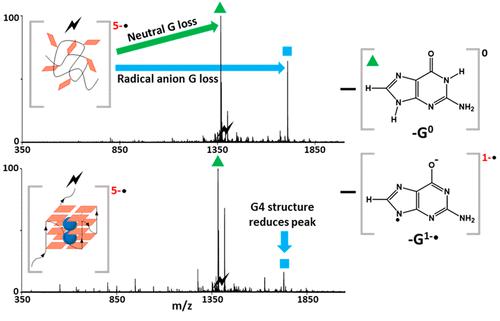当前位置:
X-MOL 学术
›
J. Am. Soc. Mass Spectrom.
›
论文详情
Our official English website, www.x-mol.net, welcomes your feedback! (Note: you will need to create a separate account there.)
Negative Electron Transfer Collision-Induced Dissociation of G-Quadruplexes: Uncovering the Guanine Radical Anion Loss Pathway
Journal of the American Society for Mass Spectrometry ( IF 3.2 ) Pub Date : 2024-03-08 , DOI: 10.1021/jasms.3c00443 Nicole M. Brundridge 1 , Jordan M. Fritz 1 , Jonathan Dickerhoff 2 , Danzhou Yang 1, 2 , Scott A. McLuckey 1
Journal of the American Society for Mass Spectrometry ( IF 3.2 ) Pub Date : 2024-03-08 , DOI: 10.1021/jasms.3c00443 Nicole M. Brundridge 1 , Jordan M. Fritz 1 , Jonathan Dickerhoff 2 , Danzhou Yang 1, 2 , Scott A. McLuckey 1
Affiliation

|
G-quadruplex (G4) DNA can form highly stable secondary structures in the presence of metal cations, and research has shown its potential as a transcriptional regulator for oncogenes in the human genome. In order to explore the interactions of DNA with metal cations using mass spectrometry, employing complementary fragmentation methods can enhance structural information. This study explores the use of ion–ion reactions for sequential negative electron transfer collision-induced dissociation (nET-CID) as a complement to traditional ion-trap CID (IT-CID). The resulting nET-CID data for G4 anions with and without metal cations show an increase in fragment ion type diversity and yield of structurally informative ions relative to IT-CID. The nET-CID yields greater sequence coverage by virtue of fragmentation at the 3′-side of thymine residues, which is lacking with IT-CID. Potassium adductions to backbone fragments in IT-CID and nET-CID spectra were nearly identical. Of note is a prominent fragment resulting from a loss of a 149 Da anion seen in nET-CID of large, G-rich sequences, proposed to be radical anion guanine loss. Neutral loss of neutral guanine (151 Da) and deprotonated nucleobase loss (150 Da) have been previously reported, but this is the first report of radical anion guanine loss (149 Da). Confirmation of the identity of the 149 Da anion results from the examination of the homonucleobase sequence 5′-GGGGGGGG-3′. Loss of a charged adenine radical anion at much lower relative abundance was also noted for the sequence 5′-AAAAAAAA-3′. DFT modeling indicates that the loss of a nucleobase as a radical anion from odd-electron nucleic acid anions is a thermodynamically favorable fragmentation pathway for G.
中文翻译:

负电子转移碰撞诱导的 G-四链体解离:揭示鸟嘌呤自由基阴离子损失途径
G-四链体 (G4) DNA 在金属阳离子存在的情况下可以形成高度稳定的二级结构,研究表明其作为人类基因组癌基因转录调节因子的潜力。为了利用质谱法探索 DNA 与金属阳离子的相互作用,采用互补断裂方法可以增强结构信息。本研究探讨了使用离子-离子反应进行连续负电子转移碰撞诱导解离 (nET-CID),作为传统离子阱 CID (IT-CID) 的补充。所得的带有和不带有金属阳离子的 G4 阴离子的 nET-CID 数据显示,相对于 IT-CID,碎片离子类型多样性和结构信息离子产量有所增加。 nET-CID 凭借胸腺嘧啶残基 3' 侧的片段化产生更大的序列覆盖率,而 IT-CID 缺乏这一点。 IT-CID 和 nET-CID 光谱中钾对主链片段的加成几乎相同。值得注意的是,在富含 G 的大序列的 nET-CID 中观察到 149 Da 阴离子丢失导致的一个突出片段,被认为是自由基阴离子鸟嘌呤丢失。中性鸟嘌呤(151 Da)的中性丢失和去质子化核碱基丢失(150 Da)之前已有报道,但这是自由基阴离子鸟嘌呤丢失(149 Da)的首次报道。通过检查同核碱基序列 5'-GGGGGGGG-3' 可以确认 149 Da 阴离子的身份。对于序列 5'-AAAAAAAA-3',还注意到相对丰度低得多的带电腺嘌呤自由基阴离子的损失。 DFT 模型表明,从奇电子核酸阴离子中失去作为自由基阴离子的核碱基对于 G. 来说是热力学上有利的断裂途径。
更新日期:2024-03-08
中文翻译:

负电子转移碰撞诱导的 G-四链体解离:揭示鸟嘌呤自由基阴离子损失途径
G-四链体 (G4) DNA 在金属阳离子存在的情况下可以形成高度稳定的二级结构,研究表明其作为人类基因组癌基因转录调节因子的潜力。为了利用质谱法探索 DNA 与金属阳离子的相互作用,采用互补断裂方法可以增强结构信息。本研究探讨了使用离子-离子反应进行连续负电子转移碰撞诱导解离 (nET-CID),作为传统离子阱 CID (IT-CID) 的补充。所得的带有和不带有金属阳离子的 G4 阴离子的 nET-CID 数据显示,相对于 IT-CID,碎片离子类型多样性和结构信息离子产量有所增加。 nET-CID 凭借胸腺嘧啶残基 3' 侧的片段化产生更大的序列覆盖率,而 IT-CID 缺乏这一点。 IT-CID 和 nET-CID 光谱中钾对主链片段的加成几乎相同。值得注意的是,在富含 G 的大序列的 nET-CID 中观察到 149 Da 阴离子丢失导致的一个突出片段,被认为是自由基阴离子鸟嘌呤丢失。中性鸟嘌呤(151 Da)的中性丢失和去质子化核碱基丢失(150 Da)之前已有报道,但这是自由基阴离子鸟嘌呤丢失(149 Da)的首次报道。通过检查同核碱基序列 5'-GGGGGGGG-3' 可以确认 149 Da 阴离子的身份。对于序列 5'-AAAAAAAA-3',还注意到相对丰度低得多的带电腺嘌呤自由基阴离子的损失。 DFT 模型表明,从奇电子核酸阴离子中失去作为自由基阴离子的核碱基对于 G. 来说是热力学上有利的断裂途径。



























 京公网安备 11010802027423号
京公网安备 11010802027423号